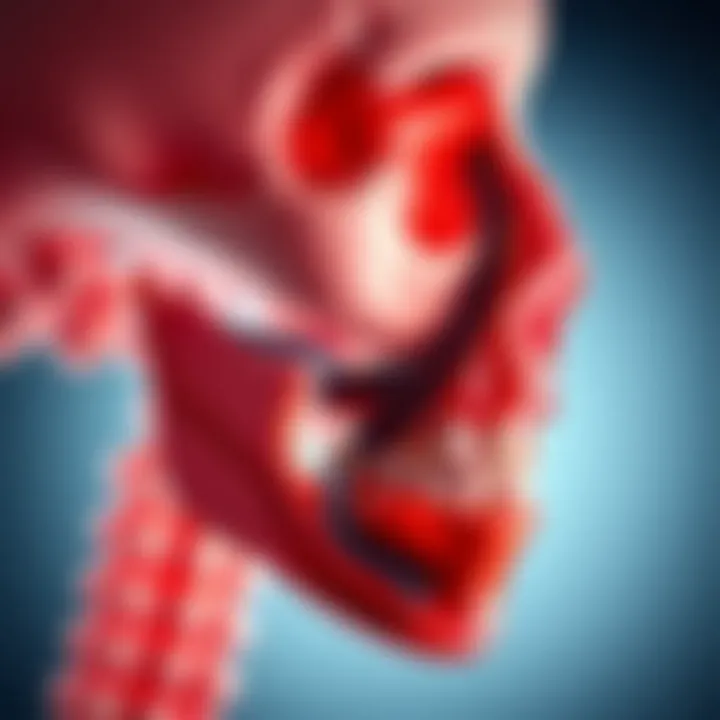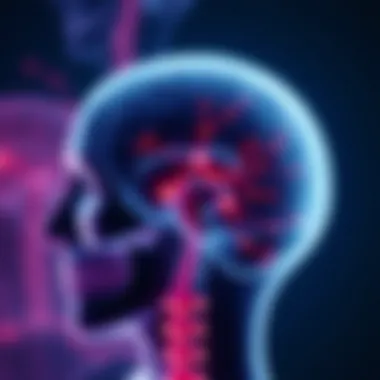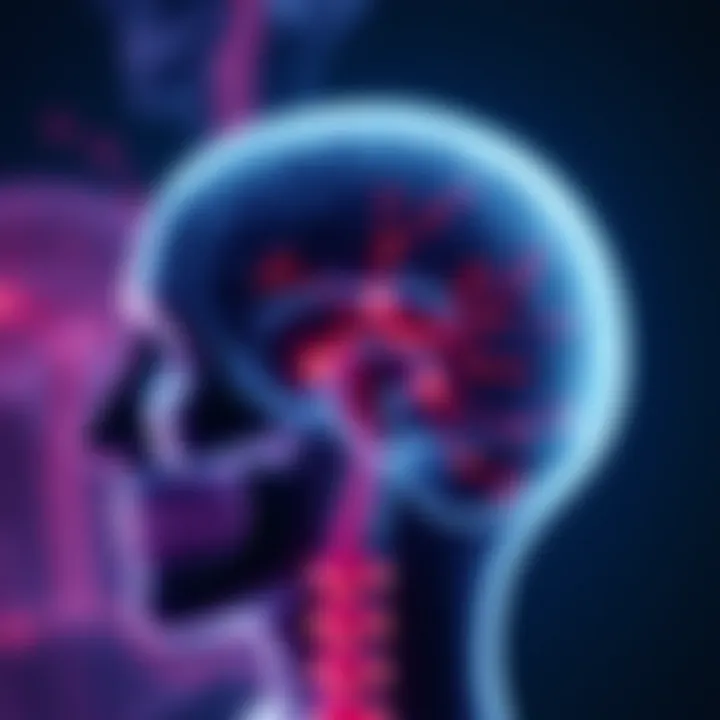TMJ Disorders: An Early Indicator of Multiple Sclerosis


Intro
The temporomandibular joint (TMJ), where the jawbone meets the skull, plays a crucial role in our everyday functions such as chewing and speaking. Yet, it isn’t just involved in jaw movements; this joint can offer significant insights into broader health issues, particularly conditions such as multiple sclerosis (MS).
In this exploration, we'll take a closer look at how TMJ disorders might signal the early onset of MS. Understanding this link could be pivotal; it may lead to earlier, more accurate diagnoses, allowing for timely interventions that could impact the quality of life of those affected.
Many patients experiencing TMJ-related pain or dysfunction often notice other symptoms that might not seem directly connected at first glance. These could include fatigue, numbness, or general weakness—symptoms frequently associated with MS. This intricate relationship raises important questions, compelling healthcare professionals to rethink how they diagnose and manage TMJ disorders, especially in young adults or individuals showing subtle signs of MS.
Thus, as we delve into this subject, it’s essential to gain insight into recent research findings, the methodologies utilized in studies, and the significance of these observations within clinical practice.
Research Highlights
Key Findings
Recent studies have started to shed light on the connection between TMJ disorders and multiple sclerosis. Some key findings include:
- Incidence of TMJ Disorders: A substantial number of patients with MS report experiencing TMJ dysfunction. This indicates a potentially strong correlation that deserves further investigation.
- Pain Types: Neuropathic pain, commonly seen in MS patients, overlaps significantly with the pain experienced in TMJ disorders. This suggests that mechanisms underlying pain perception could be interconnected.
- Inflammation Links: Research indicates that inflammatory processes, often present in MS, may contribute to the development of TMJ disorders.
"Recognizing TMJ dysfunction could help identify MS in its nascent stages, potentially altering patient outcomes through early intervention."
Implications and Applications
The implications of these findings extend far beyond theoretical discussions. They highlight the need for:
- Interdisciplinary Collaboration: Increased cooperation between neurology and dental health professionals can lead to better diagnostic protocols.
- Patient Education: Empowering patients to understand their symptoms and encouraging them to seek help when encountering TMJ issues may ultimately lead to earlier diagnoses of MS.
- Further Research: It's clear that more research is necessary to fully understand the relationship between these conditions. This could pave the way for new treatment methodologies and improve patient care strategies.
Methodology Overview
Research Design
The research conducted in this area typically employs observational studies, case studies, and longitudinal analyses to gather data on the interconnectivity of TMJ disorders and MS. Researchers often look for patterns in patient histories, symptomatology, and responses to treatments.
Experimental Procedures
Clinical trials may involve administering questionnaires that assess TMJ-related pain and dysfunction in individuals diagnosed with MS versus those without. Imaging studies, like MRI scans, help visualize any anatomical changes in the TMJ among these patients. Additionally, biological markers related to inflammation may be evaluated, contributing to understanding underlying pathophysiological processes.
Further investigations may include comparative analysis of patient groups, ensuring that any links drawn are supported by substantial data.
In summary, the potential link between TMJ disorders and early signs of multiple sclerosis represents a frontier that merges neurology with dental health, providing a pathway toward earlier and more effective management of both conditions. Delving into this connection not only enhances our understanding of MS but also underscores the necessity for a comprehensive approach to patient care.
Learn more about TMJ disorders and their symptoms here
Explore additional insights into multiple sclerosis here
Understanding Temporomandibular Joint Disorders
Grasping the nature of Temporomandibular Joint (TMJ) disorders is paramount, especially when navigating the nuanced waters of their potential relationship to multiple sclerosis (MS). This connection may not seem immediately obvious, yet understanding TMJ disorders lays the groundwork for recognizing early warning signs that might go unnoticed otherwise. These disorders pertain to conditions that affect the jaw joint and surrounding muscles, often resulting in pain and dysfunction.
Definition of TMJ Disorders
TMJ disorders encompass a range of issues related to the temporomandibular joint itself—the hinge that connects the jaw to the skull. These disorders can stem from various causes like injury, arthritis, or dental problems. Regardless of the root cause, TMJ disorders share a common thread: they disrupt normal jaw movement, leading to complications that can affect a person's overall health and well-being.
Such disorders might be easy to overlook but have significant implications. They are not merely a nuisance; they can be a source of chronic pain and discomfort that profoundly impacts the quality of life.
Common Symptoms of TMJ Disorders
Jaw pain
Jaw pain stands out as the hallmark symptom of TMJ disorders. This type of pain often manifests as a dull ache that may radiate to nearby areas, including the neck and shoulders. The unique aspect of jaw pain is its capacity to interfere with many daily activities, from eating and speaking to even resting. Such discomfort is beneficial for this discussion, as it serves as an index for both TMJ issues and potential neurological complications, including those associated with MS.
Headaches
Headaches associated with TMJ disorders can be particularly troublesome. These headaches are often tension-type or even resemble migraines, originating from strain in jaw muscles. The key characteristic that makes headaches pertinent to our exploration is their often cyclical nature; they not only result from TMJ disorders but can also exacerbate the symptoms of any underlying neurological conditions, making it a relevant piece in the puzzle of MS symptoms.


Ear pain
Ear pain is yet another symptom that seems to have no immediate connection to jaw function. However, the ear and jaw are intricately linked through shared nerves and muscle groups. This makes ear pain a significant consideration in TMJ disorders as it can lead to misdiagnosis in clinical settings. Recognizing that ear pain sometimes connects to jaw issues offers important insights for healthcare professionals when considering a diagnosis of MS, where auditory symptoms may appear early on.
Potential Causes of TMJ Disorders
Jaw misalignment
Jaw misalignment, or malocclusion, is a prevalent cause of TMJ disorders. When the teeth do not align correctly while biting, the TMJ can become strained, leading to inflammation and discomfort. Understanding the implications of jaw misalignment is crucial as it correlates with numerous symptoms and makes it possible for patients to seek the right treatment before conditions worsen.
Arthritis
Arthritis plays a significant role in the development of TMJ disorders. Osteoarthritis can lead to degenerative changes in the joint, while rheumatoid arthritis can produce inflammation. Each of these characteristics creates a distinct type of discomfort and dysfunction, which needs careful evaluation in anyone presenting with TMJ symptoms, particularly as part of a broader health assessment that may include MS.
Stress-related tension
Stress-related tension is a psychological contributor that is often overlooked. Tension in the jaw and facial muscles can lead to involuntary clenching or grinding, known as bruxism. This not only aggravates TMJ disorders but can also create a feedback loop of stress and discomfort that complicates other health issues. In these cases, recognizing the role of stress and managing it effectively can help lessen the symptoms associated with TMJ disorders while also promoting overall mental well-being.
Understanding temporomandibular joint disorders is essential for deciphering their potential early links to multiple sclerosis. By addressing the symptoms, causes, and their broader implications, healthcare providers can better equip themselves and their patients in recognizing and responding to this complex interaction.
Preamble to Multiple Sclerosis
Understanding multiple sclerosis (MS) is crucial, as it shines a light on a complex neurological disorder that can unfold in varied and sometimes subtle ways. This section aims to provide an overview, paving the way to better comprehend how conditions like TMJ disorders could possibly serve as early indicators of MS.
Definition and Overview of MS
Multiple sclerosis is often portrayed as a disease that disrupts the flow of information within the brain and between the brain and body. MS is an autoimmune disease where the body's immune system mistakenly attacks the protective covering of the nerves known as myelin. This leads to communication breakdowns and may result in the myriad symptoms that those living with MS often face.
A pivotal aspect of MS is its unpredictable nature. Symptoms can wax and wane, making it difficult for both patients and healthcare providers to grasp the full scope of the illness. For instance, a person may feel relatively well one day and struggle with debilitating symptoms the next. This variability can complicate diagnosis, as the signs of MS can mimic those of other conditions, including TMJ disorders.
Early Symptoms of Multiple Sclerosis
Being attuned to the early signs of MS is essential for timely intervention. Catching it early can make a world of difference in treatment outcomes. The key symptoms include:
- Fatigue: One of the most common complaints among individuals with MS, fatigue can be more than just feeling tired. It’s often profound and can interfere with daily activities, even with adequate rest.
- Numbness: Many people describe an unusual tingling sensation or numbness, often in the limbs. This may occur suddenly and can cause anxiety about what it might signify.
- Visual disturbances: Blurred or double vision is frequently reported among MS patients. These disturbances are often due to inflammation of the optic nerve.
Each of these symptoms resonates significantly with TMJ disorders, which can present similarly, heightening the importance of discerning between the two.
Fatigue
Fatigue in MS is not merely exhaustion; it’s a pervasive state that can feel all-consuming. Patients often express how debilitating this type of fatigue is, resembling a weight that leaves one unable to carry out even the most routine tasks. Understanding this symptom is vital as it can often be a leading indicator of disease progression, making it a key point of focus in this discussion.
Numbness
Numbness has a distinctive role; it can be a first sign that something is amiss within the nervous system. The sensation may come on suddenly, catching individuals off guard. This symptom is essential for the guide because recognizing it early could encourage individuals to seek medical advice sooner, possibly facilitating earlier diagnosis and intervention.
Visual disturbances
Visual impairments may seem straightforward, but they often vary in presentation. Fluctuations in vision can create confusion and concern for individuals, leading them to question their health. This characteristic of visual disturbances underscores the necessity for careful monitoring and awareness in potential MS patients.
Pathophysiology of MS
The understanding of MS is further enriched by delving into its underlying mechanisms. Specifically, recognizing how the body's own defense system may misconstrue healthy nerves as threats is imperative for an integrated understanding of this disease.
- Autoimmune response: The body's immune system should protect us, but in MS, it misfires, attacking the myelin. Understanding this response is crucial, as it frames the treatment landscape significantly.
- Demyelination: As attacks on the myelin occur, the loss of this protective layer leads to demyelination of the nerves. This aspect brings into focus the process that contributes to nerve signal disruption, correlating with symptoms.
- Neural damage: Continuous demyelination culminates in neuronal injury, which is the core issue of MS. Grasping the relationship between neural damage and symptoms is pivotal for grasping the intensity of this condition and how TMJ might interact with these pathways.
Exploring the Link Between TMJ Disorders and MS
Understanding the connection between temporomandibular joint (TMJ) disorders and multiple sclerosis (MS) is of utmost relevance in today’s medical dialogue. TMJ disorders can manifest subtly, but their implications might stretch far beyond mere jaw discomfort. This section delves into crucial elements like clinical observations, theoretical mechanisms, and raw data from recent studies. It does not only shed light on potential early indicators of MS but also equips healthcare professionals with insights necessary for timely interventions.
Clinical Observations and Anecdotal Evidence


Clinical observations have continuously pointed towards a potential relationship between TMJ disorders and multiple sclerosis. For example, many patients suffering from TMJ disorders have reported increased anxiety, fatigue, and peripheral discomfort, which are often symptoms noted in MS cases. Such observations may suggest a clinical overlap that requires further investigation.
Additionally, anecdotal evidence from patients offers a rich perspective, indicating that some experience TMJ symptoms, such as jaw pain or discomfort around the ears, well before any definitive diagnosis of MS. These insights provide a more personalized account, emphasizing the necessity for clinicians to listen to patients’ narratives. Engaging with these stories can guide exploratory diagnosis for MS earlier rather than later, ultimately leading to better patient outcomes.
Theoretical Mechanisms Connecting TMJ and MS
Neurological Pathways
The connection through neurological pathways is particularly intricate. The TMJ directly interacts with several neural networks linked to pain processing and autonomic responses. When TMJ disorder is present, neural pathways can become hyperactivated, signaling pain and dysfunction.
This hyperactivity might play a role in escalating the autoimmune response seen in MS, as the body’s systems are continuously on alert, which particularly affects patients with TMJ dysfunction. Notably, this suggests that TMJ disorders could potentially trigger or worsen neurological conditions, building a case for its clinical relevance in MS assessment.
Chronic Inflammation
Chronic inflammation is another significant mechanism underpinning the potential linkage between TMJ disorders and MS. Inflammation can originate in the temporomandibular joint due to overuse, injuries, or stress, causing localized swelling and pain. As inflammation persists, it can travel through the bloodstream or affect surrounding tissues, potentially influencing the neurologic landscapes involved in MS.
This connection highlights how localized TMJ disorders may have broader implications for systemic health, particularly in autoimmune contexts like MS. It hints at the importance of addressing TMJ symptoms not just as isolated incidents but as possibly revealing red flags for underlying systemic issues.
Case Studies and Research Findings
Diving into specific case studies reveals a tapestry of clinical observations. For instance, a study published in a prominent medical journal highlighted patients who had experienced TMJ disorders, only to later be diagnosed with MS. These cases shared similar profiles: increased episodes of oral discomfort and reporting fatigue as an initial concern.
Research findings further stress the potential link, with investigations paving the way for a more robust understanding of how TMJ disorders could indeed act as precursors in some MS cases. Through ongoing research, the aim is to equip practitioners with tools to identify these connections earlier, allowing for interventions that might lead to better management of both conditions.
Ultimately, exploring this link not only enriches our understanding of TMJ disorders but also shines a light on a possible earlier recognition of multiple sclerosis, which could profoundly alter treatment trajectories and patient experiences.
Challenges in Diagnosis
Diagnosing temporomandibular joint (TMJ) disorders in conjunction with early multiple sclerosis (MS) symptoms presents several unique challenges. Recognizing the intricate relationship between these two conditions is crucial for effective treatment and management. Often, symptoms can overlap, leading to misdiagnoses and delayed care. As a result, understanding these challenges is key for both healthcare providers and patients alike.
Differentiating TMJ Disorders from MS Symptoms
When symptoms such as jaw pain, fatigue, and headaches arise, differentiating between TMJ disorders and early signs of MS becomes a tall order. TMJ disorders frequently manifest through specific indicators like:
- Jaw pain or tenderness
- Headaches that can mimic migraines
- Ear pain or pressure
However, these symptoms can also appear in MS. For instance, patients with MS might experience neuralgia, where pain radiates from the face or jaw due to demyelination affecting cranial nerves. This ambiguity can lead to the wrong conclusions if a thorough history and examination are not conducted.
Furthermore, fatigue and numbness, common in MS, may also be felt by individuals struggling with TMJ disorders, especially if stress and anxiety exacerbate their condition. Healthcare professionals must employ a detailed clinical evaluation and consider the full spectrum of symptoms to accurately separate the two. Early misdiagnosis can lead to ineffective treatment options, allowing the underlying MS to advance undetected, which is not a scenario anyone wants to face.
Role of Neurologists and Dentists
Effective management hinges on a multi-disciplinary approach. Neurologists and dentists play pivotal roles in this diagnostic process. Each specialty brings expertise that can clarify and pinpoint issues. Dentists, particularly those specialized in TMJ disorders, are equipped to evaluate oral and facial pain through clinical assessments. They utilize imaging techniques like MRI or CT scans to visualize TMJ functionality and jaw alignment.
On the other hand, neurologists focus on the broader implications of neurological symptoms related to MS. Collaborating with these specialists can streamline the diagnostic process. Joint consultations may involve sharing patient records, symptoms, and treatment responses which can significantly enhance diagnostic accuracy.
Additionally, comprehensive evaluations by both professionals can pave the way for recognizing patterns that might signify the onset of MS, such as the correlation of joint stress and neurological decline.
In summary, acknowledging the distinctive challenges in diagnosing TMJ disorders versus MS symptoms is essential for optimized patient outcomes. With collaborative effort from dedicated specialists, the road to accurate diagnosis can be navigated more clearly, providing a better chance for timely intervention and management of both conditions.
"A comprehensive view that integrates dental and neurological perspectives is crucial in tackling the challenges of diagnosis in these intertwined conditions."
For a deeper look into diagnosing TMJ and MS, you can explore National Institute of Neurological Disorders and Stroke or American Dental Association.
Implications for Treatment and Management
The relationship between temporomandibular joint disorders (TMJ) and the early signs of multiple sclerosis (MS) is nuanced, demanding a comprehensive approach to treatment and management. Understanding the implications here helps not just the healthcare professionals, but also patients grappling with both conditions. Recognizing TMJ issues as potential early indicators of MS can aid in timely diagnosis and intervention, ultimately leading to improved outcomes.
Therapeutic Approaches for TMJ Disorders
Physical therapy


Physical therapy provides a proactive avenue for addressing TMJ disorders. It focuses on strengthening the muscles around the jaw and improving jaw mobility. As a structured, non-invasive treatment, physical therapy is often favored because it helps alleviate symptoms without the immediate need for medications or surgeries. One key characteristic of physical therapy is its personalized approach. Each session is tailored to the individual, based on their specific symptoms and needs.
A unique feature of physical therapy is the variety of techniques that can be employed, including exercises to improve range of motion and strength training for the jaw muscles. While the advantages of physical therapy are significant—it often results in reduced pain and increased function—patients may find it requires time and patience to see substantial results.
Medications
Medications can play a pivotal role in the management of TMJ disorders, particularly for managing pain and inflammation. Non-steroidal anti-inflammatory drugs (NSAIDs), for instance, can help mitigate discomfort that might arise from TMJ issues. The convenience of medications makes them a popular choice among patients seeking quick relief from symptoms.
One noteworthy aspect of utilizing medications is the diverse range available, from over-the-counter pain relievers to prescription muscle relaxants. While this flexibility allows patients to find a suitable option, it is important to remember that long-term reliance on medications may lead to side effects or dependency issues. Therefore, it’s crucial to have an open discussion with a healthcare provider about the appropriate use of medications.
Surgical options
For some individuals, surgical options might be necessary if conservative treatments fail to provide adequate relief. Surgical interventions can be tailored to the specific underlying cause of TMJ disorders, ranging from arthroscopy to open joint surgery. This approach is particularly beneficial in cases where structural abnormalities are present.
However, surgical options come with inherent risks, and the recovery process can be lengthy and fraught with its own challenges. This is perhaps what makes surgery a choice of last resort for many. Patients need to weigh the benefits against the potential complications, making it imperative to consult with qualified specialists.
Preventive Strategies in At-Risk Populations
Promoting awareness and proactive measures can be pivotal for at-risk populations, those potentially teetering towards the manifestations of TMJ and MS. By encouraging lifestyle changes, including stress management techniques and the adoption of protective dental practices, the likelihood of developing TMJ issues may be mitigated.
Also, health professionals need to maintain a keen eye on individuals with symptoms that align with both TMJ disorders and MS, implementing screening processes that could enhance early detection.
For healthcare providers, educating patients about the potential connection between these two conditions is crucial.
Being vigilant regarding TMJ symptoms could lead to earlier MS diagnosis, fostering better management and treatment outcomes in the long run.
Engaging with research findings and staying updated with the latest studies can equip healthcare professionals with informed strategies for tackling both TMJ disorders and the early signs of MS.
Future Directions in Research
The intersection of temporomandibular joint (TMJ) disorders and multiple sclerosis (MS) is an emerging area that warrants further investigation. Conducting comprehensive research here isn't just a nice-to-have—it's critical. As healthcare providers increasingly recognize TMJ as a potential early marker for MS, developing precise research paths can lead to better diagnosis methods and interventions for affected individuals. The potential benefits of such research are ample. By establishing a clearer connection between these two conditions, healthcare professionals could facilitate earlier detection and improve clinical outcomes for patients who might be at risk.
Need for Longitudinal Studies
A major gap in the present research is the lack of longitudinal studies that follow individuals with TMJ disorders over a significant period. Such studies could provide invaluable insights into the progression of symptoms related to both TMJ and MS. For instance, tracking patients’ health over several years, researchers can identify patterns that link TMJ dysfunction to later development of MS. This could illuminate whether TMJ issues precede MS or if they are simply concurrent symptoms of a broader neurological condition.
Key points for longitudinal studies include:
- Patient Tracking: Monitoring changes in both TMJ symptoms and neurological health regularly.
- Data Analysis: Examining correlations between severity and progression of TMJ disorders and subsequent MS symptoms.
- Sample Size: Ensuring that diverse populations are included can strengthen the findings.
By laying out a roadmap that includes long-term observation, researchers can gather concrete data that either substantiates or challenges the notion of TMJ disorders as an early warning signal for MS.
Potential for New Diagnostic Protocols
As research progresses, the potential for new diagnostic protocols specific to TMJ and MS connection becomes more tangible. The development of standardized diagnostic criteria could significantly enhance the identification of at-risk patients. This initiative could involve several aspects:
- Integrated Approaches: Combining neurology and dentistry more closely in diagnostic procedures.
- Refined Imaging Techniques: Utilizing advanced imaging methods like MRI to assess TMJ-related changes and their potential link to demyelination processes in the brain.
- Biomarker Identification: Research could lead to the establishment of biomarkers that indicate inflammation or other relevant changes before the onset of clinical MS symptoms.
"Investing in research today lays the foundation for breakthroughs that enhance patient care tomorrow."
Ultimately, the goal of developing improved diagnostic protocols would be to facilitate earlier interventions. By catching TMJ disorders that may signal a propensity for MS before they fully develop, healthcare professionals could initiate treatment strategies aimed at alleviating both TMJ and MS symptoms, potentially improving quality of life for affected patients.
Finale
Addressing the relationship between temporomandibular joint (TMJ) disorders and multiple sclerosis (MS) highlights an essential area of concern in both dental and neurological spheres. Understanding how TMJ disorders could serve as an early indicator of MS presents a valuable perspective for clinicians. Early detection is critical in managing MS effectively, and recognizing TMJ symptoms may provide a pathway for timely intervention.
Summary of Findings
Throughout this article, we delved into various facets surrounding the correlation between TMJ disorders and the early signs of multiple sclerosis. Some key points emerge:
- Clinical Observations: There’s a growing body of clinical observations suggesting that patients with TMJ disorders may have a higher likelihood of developing MS. The pain and dysfunction associated with TMJ might not only affect jaw function but could also signal underlying neurological complications.
- Theoretical Connections: The proposed mechanisms, including neurological pathways and chronic inflammation, indicate that TMJ-related pain may impact not only local structures but also distant neurological networks.
- Diagnostic Challenges: Differentiating between the symptoms of TMJ disorders and those of MS can be tricky. Both conditions share some overlapping features, making it essential for healthcare professionals to have a keen eye and comprehensive approach when diagnosing patients.
- Future Directions: Research into longitudinal studies and the potential for new diagnostic protocols could better illuminate the complexities of this connection, paving the way for improved strategies in treating patients.
Final Thoughts on TMJ and MS Relationship
The relationship between TMJ disorders and multiple sclerosis deserves significant attention from both the medical and dental communities. As practitioners look deeper into the nuances of these conditions, the hope is for heightened awareness and understanding among patients as well.
"Early recognition of TMJ symptoms in the context of MS could lead to a more proactive approach in managing both conditions, ultimately improving patients' quality of life."
Even as we advance our knowledge of TMJ disorders and their potential to be indicative of MS, ongoing education remains key. The integration of information from neurology and dentistry will be paramount in developing effective treatment modalities that address not just symptoms, but also underlying causes. As we continue exploring this junction of disciplines, the initiative must emerge to unravel how early indicators such as TMJ disorders can guide future research and patient care.



